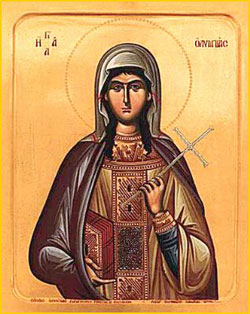We ask you, urgently: don’t scroll past this
Dear readers, Catholic Online was de-platformed by Shopify for our pro-life beliefs. They shut down our Catholic Online, Catholic Online School, Prayer Candles, and Catholic Online Learning Resources—essential faith tools serving over 1.4 million students and millions of families worldwide. Our founders, now in their 70's, just gave their entire life savings to protect this mission. But fewer than 2% of readers donate. If everyone gave just $5, the cost of a coffee, we could rebuild stronger and keep Catholic education free for all. Stand with us in faith. Thank you.Help Now >
How did a Spanish nun evangelize American natives BEFORE the arrival of European settlers in North America?
FREE Catholic Classes
In the 1620s, while the pilgrims were landing on Plymouth Rock and having the first Thanksgiving, the Jumano tribe in Texas (before it was Texas) were allegedly having mysterious encounters with what they called the "Lady in Blue."

How did Sr. Maria de Agreda evangelize Native Americans from Spain? The answer is a miracle.
Highlights
Catholic Online (https://www.catholic.org)
9/15/2017 (7 years ago)
Published in Living Faith
Keywords: Saints, Miracles, Catholic News, Bi-Location
San Angelo, Texas (CNA/EWTN News) - A young, ethereal lady, dressed in a habit with a blue cape, is said to have appeared to the Jumano Native Americans numerous times during these years, speaking to them in their native language and instructing them in the Christian faith.
Thousands of miles away, in a cloistered convent in Spain, Sr. Maria de Agreda was reporting mystical visits that would occur during prayer, often during Mass after receiving communion, to a tribe of native people in what was called New Spain at the time.
"She would have these prayerful, mystical experiences of coming here to the New World and visiting these people and evangelizing them, sharing the faith with them," Bishop Michael Sis of the Diocese of San Angelo, Texas, told CNA.
"And when she came, she encouraged them to go to the missions where the Franciscan priests were and request baptism," he added.
Just recently, the Vatican has re-opened the cause for canonization of Sr. Maria de Agreda, who besides her mystical experiences and apparitions was a prolific writer, particularly on the topic of the Blessed Virgin Mary.
She has been declared Venerable, and her body was also found to be incorrupt when it was exhumed in 1909 and is now resting in view in her convent in Spain.
In August, Fr. Stefano M. Cecchin, the vice postulator of Sr. Maria de Agreda's cause for canonization, spent a week in San Angelo, Texas, where Sr. Maria reportedly appeared to the Jumano natives, investigating the devotion to her that still exists today.
"This is an important story that needs be told," Fr. Cecchin told the San Angelo Standard Times.
According to records kept by the missionaries in the area, Sr. Maria's promptings led as many as 2,000 Jumano natives to be baptized.
Most of their ancestors in the San Angelo area are still Catholic, and still have a strong devotion to the "Lady in Blue" who brought them the Catholic faith, Bishop Sis said.
Regarding her possible bi-location, Fr. Cecchin added: "There is a lot of proof that the Lady in Blue appeared to the Jumano Tribe."
The Vatican has never ruled definitively on whether her apparitions to what is now present-day western Texas and eastern New Mexico constitute a true instance of bi-location. However, there are some remarkable connections between Sr. Maria's mystical experiences, and the Lady in Blue that the Jumano people saw, Bishop Sis said.
She earned the name "Lady in Blue" because the Jumano natives reportedly saw a woman wearing a blue cape. Sr. Maria belonged to a Franciscan order of nuns called the Conceptionistas, who wear a white habit with a blue cloak. The order still has convents in Spain and Latin America today, including Sr. Maria's convent in Agreda.
From her cloister, having never traveled to the New World, Sr. Maria was able to describe the new plants and animals there, as well as the way the people dressed and painted themselves. She described the landscape as a place where two rivers meet -- and in San Angelo, the Middle Concho River is joined by the South Concho River.
Especially remarkable, Bishop Sis said, is that she described meeting a leader with one eye, while the Franciscan missionaries in the area at the time also reported meeting a Jumano leader with one good eye and one bad eye.
"So that's a fascinating detail, that shows a concrete connection between this place and her descriptions of the people," he said.
According to the Texas Almanac, Friar Alonso de Benavides of the Franciscans in New Mexico was the first to confirm the story of the "Lady in Blue." He reported the incidents of her appearances to the Spanish court in 1630, and shortly thereafter was able to interview Sr. Maria de Agreda at her convent, where he was able to cross-reference the details of the apparitions from both Sr. Maria and the Jumano natives' perspective.
"The first time she went was in the year 1620. She had continued ever since ... She gave me all their signs and (declared) she had been with them," the friar wrote at the times.
"She knows Captain Tuerto (the one-eyed captain) very well, having given me his personal characteristics and that of all the others. She herself sent the messengers from Quivira (the Jumano village on the Plains) to call the missionaries."
Reportedly, the bi-locations of Sr. Maria de Agreda ceased after her goal was accomplished -- that the Jumano native people were able to receive the sacraments.
If Sr. Maria de Agreda truly bi-located, it wouldn't be the only time this phenomenon was reported.
While it's more common to have Jesus or Mary or saints in heaven appear to people in apparitions, several saints have reportedly bi-located while they were still alive on earth.
Perhaps one of the best-known bi-locating saints in recent times is St. Padre Pio, a mystical Capuchin priest who reportedly appeared to numerous people throughout the world while he was living in Italy.
During World War II, numerous American pilots said that a mysterious friar would appear to them in the air over San Giovanni Rotondo, which was occupied by Nazis at the time. When the American pilots would try to bomb the Rotondo, the friar would appear and stretch out his hands, and their bombs would drop on open plains nearby.
After the war, a pilot visited the friary and immediately recognized Padre Pio as the one who had appeared to them over the city.
Questioned about the strange incidents of his bi-location, Padre Pio once said that they simply occurred "by an extension of his personality."
Unlike apparitions of Mary or Jesus, which the Vatican heavily investigates, instances of bi-locations or apparitions of saints are typically not formally investigated by the Vatican, said Michael O'Neill, a Catholic miracle researcher who recently published a book on miraculous apparitions in the Church.
O'Neill said that apparitions or bi-locations of saints simply "adds to the story of the saint, their reputation of holiness, and the devotion that arises around a saint," O'Neill said.
Those stories can be a part of establishing a saint's reputation for holiness, and in Sr. Maria's case "to show that there's a great devotion to her even outside of Spain," he said.
"She has been declared Venerable," said Bishop Sis, noting that the next step in her cause would be beatification.
"The question of her being beatified or canonized doesn't really rest on the experience of these apparitions...what's most important is the virtue of her life and her writings," he added.
Her best-known work is "The Mystical City of God: Life of the Virgin Mother of God," in which she writes about details of Mary's life that she said came to her in prayer. It's no mistake, Bishop Sis added, that the vice postulator of her cause is a theologian and Marian expert who also serves as the president of the Pontifical Marian Academy in Rome.
"So that's his main goal at this time, to study her mystical Marian theology," and to do a thorough investigation of her other writings and her life, he said.
The "Lady in Blue" continues to be a central figure of the history and devotion for Catholics in Texas.
A historical marker shows where the Franciscan mission once stood. The "Lady in Blue Committee" is especially active in promoting her story and legacy, and is in the process of building bronze statue of Sr. Maria de Agreda with a Jumano native.
Sr. Maria de Agreda would have appeared "before Junipero Serra, before the Alamo, that was the time of the first Thanksgiving," Bishop Sis said.
"So it's a beautiful, historic experience of evangelization, and it shows our rich Catholic history in this part of the world, and is a great testament of faith," he said, both of the Conceptionista sisters, and the Jumano ancestors who have kept their faith.
Why is YouTube censoring the BIBLE?
---
'Help Give every Student and Teacher FREE resources for a world-class Moral Catholic Education'
Copyright 2021 - Distributed by Catholic Online
Join the Movement
When you sign up below, you don't just join an email list - you're joining an entire movement for Free world class Catholic education.

-

-
Mysteries of the Rosary
-
St. Faustina Kowalska
-
Litany of the Blessed Virgin Mary
-
Saint of the Day for Wednesday, Oct 4th, 2023
-
Popular Saints
-
St. Francis of Assisi
-
Bible
-
Female / Women Saints
-
7 Morning Prayers you need to get your day started with God
-
Litany of the Blessed Virgin Mary
Tragedy Strikes Abundant Life Christian School in Madison, Wisconsin, Days Before Christmas
-

Celebrate Sunday Mass - 12.15.24
-

The Day Prayer Left the Classroom: Why It Should Never Have Happened
-
Do Aborted, Stillborn, and Miscarried Babies Go to Heaven?
-
Celebrating St. Juan Diego: The Man Chosen by Our Lady of Guadalupe
Daily Catholic
 Daily Readings for Tuesday, December 17, 2024
Daily Readings for Tuesday, December 17, 2024 St. Olympias: Saint of the Day for Tuesday, December 17, 2024
St. Olympias: Saint of the Day for Tuesday, December 17, 2024 A Devotion in Honour of the Seven Sorrows and Joys of Saint Joseph: Prayer of the Day for Tuesday, December 17, 2024
A Devotion in Honour of the Seven Sorrows and Joys of Saint Joseph: Prayer of the Day for Tuesday, December 17, 2024- Daily Readings for Monday, December 16, 2024
- St. Ado of Vienne: Saint of the Day for Monday, December 16, 2024
- Be with Me Today, O Lord: Prayer of the Day for Monday, December 16, 2024
![]()
Copyright 2024 Catholic Online. All materials contained on this site, whether written, audible or visual are the exclusive property of Catholic Online and are protected under U.S. and International copyright laws, © Copyright 2024 Catholic Online. Any unauthorized use, without prior written consent of Catholic Online is strictly forbidden and prohibited.
Catholic Online is a Project of Your Catholic Voice Foundation, a Not-for-Profit Corporation. Your Catholic Voice Foundation has been granted a recognition of tax exemption under Section 501(c)(3) of the Internal Revenue Code. Federal Tax Identification Number: 81-0596847. Your gift is tax-deductible as allowed by law.









 Daily Readings for Tuesday, December 17, 2024
Daily Readings for Tuesday, December 17, 2024 St. Olympias: Saint of the Day for Tuesday, December 17, 2024
St. Olympias: Saint of the Day for Tuesday, December 17, 2024 A Devotion in Honour of the Seven Sorrows and Joys of Saint Joseph: Prayer of the Day for Tuesday, December 17, 2024
A Devotion in Honour of the Seven Sorrows and Joys of Saint Joseph: Prayer of the Day for Tuesday, December 17, 2024

